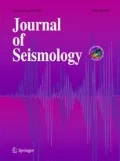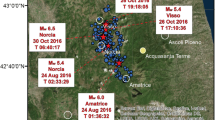Abstract
During the months of June–July 2017, the Lake Ohrid area in the southwestern Macedonia experienced a series of small to intermediate earthquakes. More than a thousand earthquakes occurred in that period, all in the epicentral area about 10 km east-northeast from Ohrid city center. The earthquakes showed characteristics of a swarm with 50 of them having magnitudes of 3 or greater and the strongest reaching magnitude M5.0. The earthquakes caused concern among the people in Ohrid and neighboring cities and villages and prompted the installation of two networks of temporary stations. One network was deployed in the epicentral area to determine in more detail the earthquakes’ depth and source parameters. The other urban network of instruments was installed to monitor the influence of the ground on the amplification of shaking and the dynamics of structures in the city of Ohrid. In this study, a selection of the urban network strong motion (SM) records was analyzed for the first time. Accelerograph records from a magnitude M3.1 earthquake recorded at eight places in the city and from the two earthquakes with magnitudes M4.2 and M5.0 recorded at the permanent seismological station Ohrid (code OHR) were used. The results of the behavior of the instrumented building were also compared with the findings of previous experiments. The differences in the spectral values on the SM records from the stations were investigated in respect to the ground conditions and location where the instruments were installed, i.e., bedrock and sediments at the sites. The power spectra and the H/V ratio of the earthquake records from the 2017 seismic sequence in the Ohrid area were also viewed in respect to the Eurocode-8. In addition to being used as part of standard engineering practice, this information about the local soil conditions can be of interest to geophysicists in seismic and geotechnical investigations, as well as in seismic risk-assessment applications.















Similar content being viewed by others
References
Burchfiel BC, King RW, Todosov A, Kotzev V, Durmurdzanov N, Serafimovski T, Nurce B (2006) GPS results for Macedonia and its importance for the tectonics of the Southern Balkan extensional regime. Tectonophysics 413:239–248
Dojcinovski D, Olumceva T, Atanasovski S, Prenkovski V (2010) 3D real network - modern techniques for monitoring of capital structures. CARDS Standardisation, Accreditation and Conformity Assessment Project, Tirana
Eurocode-8 (MKC EN 1998-1:2012) Design of structures for earthquake resistance – part 1: general rules, seismic actions and rules for buildings, Standardization Institute of the Republic of Macedonia
Hadzievski D (1976) Seismicity on the territory of S.R. Macedonia. Seismic Observatory of the University “Cyril & Methodius”, Skopje
Hoffmann N, Reicherter K, Fernandez-Steeger T, Grützner C (2010) Evolution of ancient Lake Ohrid: a tectonic perspective. Biogeosciences 7:3377–3386
Milutinovic Z, Cernih D, Dumurdzanov N, Salic R, Drogreska K, Pekevski L, Chejkovska V, Najdovska J, Tomic D (2017) Seismic hazard and review of seismic activity of Ohrid epicentral area in the period June–July 2017, PORTA3, No. 258, pp. 12–16, in Macedonian
Nakamura Y (1989) A method for dynamic characteristics estimation of subsurface using microtremor on the ground surface. Q Rep RTRI 30(1):25–33
Pekevski L (2002) Q for the territory of Republic of Macedonia, Alb. J Nat Tech Sci 10:81–87
Petrovski J (2003) Damaging effects of the July 26, 1963 Skopje earthquake. In Proceedings of European Earthquake Engineering Conference, Skopje-Ohrid, Macedonia, Compilation
Petrovski J, Vlaski V, Jordanovski Lj, Milutinovic Z (1995) Characteristics of earthquake ground motions obtained on the Ohrid Lake three dimensional strong motion array in the Republic of Macedonia, 10th European Conference on Earthquake Engineering, Balkema, Rotterdam, pp 235–240
Sinadinovski C, McCue KF (2003) Earthquakes in dissimilar tectonic regimes - comparison study of two shallow events with similar magnitudes, in Earthquake risk mitigation. Proceedings of the Australian Earthquake Engineering Society Conference, Melbourne, Victoria, Australia, Compilation
UNESCO (1968) Geological and seismological investigations in the Skopje area. Proceedings of the 1964 international seminar on earthquake engineering. Skopje, Macedonia, Compilation
Van Camp M, Vauterin P (2005) Tsoft: graphical and interactive software for the analysis of time series and Earth tides. Comput Geosci 31(5):631–640
Аrsovski М, Petkovski R (1975) Neotectonics of SR Macedonia, Publication 49, IZIIS: Skopje
Acknowledgements
The authors are thankful to the management of the UKIM Seismological Observatory and the Institute of Earthquake Engineering and Engineering Seismology (IZIIS) in Skopje for the permission to publish these unique datasets. Additional acknowledgment goes to the team members who installed the stations and collected and processed the data. The junior staff at SKO Observatory Monika Andreeska and Arse Kuzmanovski is credited for mapping and assistance in interpretation. Special gratitude goes to the reviewers of the article for the journal, whose comments greatly improve its clarity and organization.
Author information
Authors and Affiliations
Corresponding author
Rights and permissions
About this article
Cite this article
Sinadinovski, C., Pekevski, L., Dojcinovski, D. et al. Comparative analysis of strong motion (SM) records from the July 2017 Ohrid seismic sequence. J Seismol 22, 1451–1467 (2018). https://doi.org/10.1007/s10950-018-9777-2
Received:
Accepted:
Published:
Issue Date:
DOI: https://doi.org/10.1007/s10950-018-9777-2




